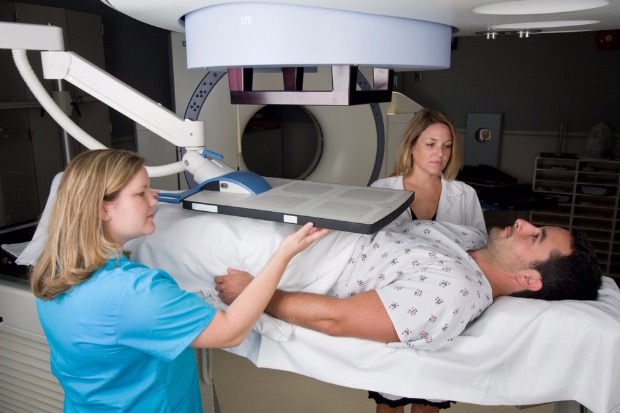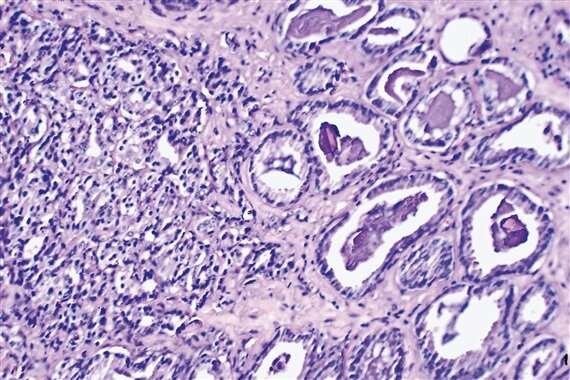 Prostate cancer is currently the most commonly diagnosed solid organ tumor type among men in the US; each year an estimated 233,000 new arise and 29,480 deaths from the disease occurred in 2014. A new study by UCLA Jonsson Comprehensive Cancer Center researchers may lead to improvements in prostate cancer treatment. The findings were published online on February 19 in the journal JAMA Oncology.
Prostate cancer is currently the most commonly diagnosed solid organ tumor type among men in the US; each year an estimated 233,000 new arise and 29,480 deaths from the disease occurred in 2014. A new study by UCLA Jonsson Comprehensive Cancer Center researchers may lead to improvements in prostate cancer treatment. The findings were published online on February 19 in the journal JAMA Oncology.
The study authors note that earlier diagnosis and treatment advances have resulted in the increased use of aggressive local treatments, particularly radiation therapy; however, that treatment comes with a risk of adverse effects. Patients must often take into consideration the recommendations of their physicians, the aggressiveness of their cancer, undergoing active surveillance or treatment, and healthcare costs. For the study, a research team led by UCLA Jonsson Comprehensive Cancer Center member Dr. Karim Chamie examined the insurance claims data of more than 37,000 patients over a three-year period (2004 to 2007); the data was furnished by the Surveillance, Epidemiology and End Results (SEER) Program of the National Cancer Institute (NCI).
The investigators found that radiation therapy was the most common treatment (58%), followed by radical prostatectomy (a surgical procedure to remove the prostate; 19%). Other treatments comprised the remaining 10%. This 10% included watchful waiting, where physicians follow the patient without treatment to determine whether the cancer progresses, and active surveillance, whereby patients undergo routine biopsies, blood tests and MRI to determine whether the cancer is progressing. Under either surveillance method, if cancer progression is noted, active treatment is begun.
The researchers found that radiation was the most common treatment prescribed regardless of cancer stage, prostate-specific antigen (PSA) level, cancer grade, or the patient’s life expectancy. The most significant predictor of a man receiving radiation therapy was a referral to a radiation oncologist. Conversely, urologists and surgeons significantly weighed in the age and health of the patient as well as the aggressiveness of the cancer when recommending surgery.
“Doctors and patients view radiation as safe,” noted Dr. Chamie, an assistant professor of urology. He added, “There’s no anesthesia or hospitalization, the patient comes in for 15 or 20 minutes for their daily radiation treatment, it’s localized to a specific area, then they get to go home. They often don’t notice any immediate effects upfront.” However, by two years after treatment, the men wh underwent radiation therapy often begin to suffer from side effects. These can include urinary incontinence and leakage of urine, anal leakage, bowel dysfunction, erectile dysfunction, blood in the urine, and radiation cystitis. These side effects may vary from mild to very severe.
If a patient has an aggressive prostate cancer and has a long life expectancy, then these side effects and risks may be significantly outweighed by the benefits of the radiation treatment; however, if a man with a slow growing prostate tumor and a limited life expectancy is treated with radiation therapy then suffers from these side effects during the later year of his life, then he derives no benefit and only suffers from the toxicity. Dr. Chamie is hopeful that the study’s findings can enlighten the public and allow physicians to make an informed decision when it comes to determining the best treatment option for men who may or may not benefit from radiation therapy in the long run.
“Men fighting this disease don’t always need radiation or surgery as their only choice,” explained Dr. Chamie. He added, “As we find more reports demonstrating the safety and efficacy of active surveillance, I hope patients and physicians look to this as the first treatment option for low-risk and indolent disease. Here at UCLA, I am proud to say that we have a robust active surveillance program that utilizes MRI and targeted biopsies to monitor and survey these indolent tumors.”



